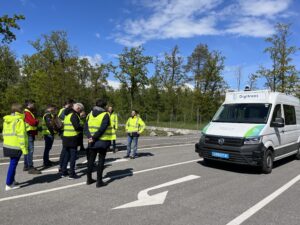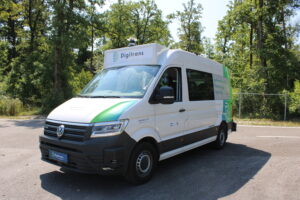AD and ADAS testing in the rain at the Digitrans Testcenter for automated driving.
Sensor Tests in the Rain – Site Visit of the Outdoor rain plant at the Digitrans Test Center St. Valentin – An Interview with Dr. Christoph Feichtinger, Director R&D at Digitrans.
After two years of construction, a unique outdoor sprinkler system was put into operation in November at the Digitrans test center for automated driving on the test track in St. Valentin. The facility in St. Valentin can replicate natural rain with different intensities and droplet size distributions – at the push of a button. The aim is to make testing the performance of sensors (LiDAR, radar, camera) in automated vehicles more realistic and easier to plan.
For which tests was the Outdoor rain plant at the Digitrans Test Center for automated driving designed?
The outdoor rain plant at the Digitrans Test Center for automated driving in St. Valentin is a unique facility that can reproduce natural rain with different intensities and droplet size distributions at the push of a button.
The rain facility is primarily designed for testing sensors (LiDAR, Radar, Camera) and algorithms of automated and autonomous technologies (AD and ADAS testing) under adverse weather conditions.
With the outdoor rain plant in St. Valentin, we deliver the first facility that allows to reproducibly test the performance and limits of sensors and algorithms under different rain intensities in a realistic outdoor environment. And that at the push of a button!
How does the outdoor rain plant for testing autonomous driving functions work in the rain?
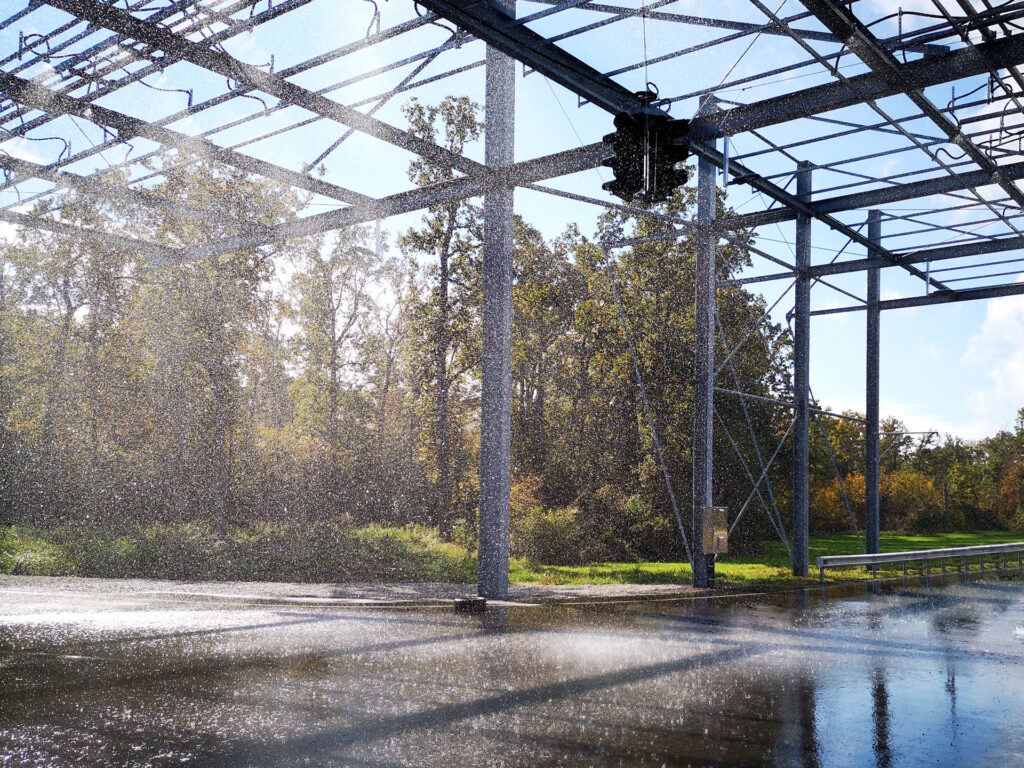

Outdoor rain plant in action on the Digitrans test center in St. Valentin with a view of the predefined nozzles © DigiTrans GmbH
Several specially predefined nozzles are mounted on a large steel structure at the Digitrans test center on the proving ground in St. Valentin. The nozzles are located at a variety of defined positions on the steel structure to generate a homogeneous rain field with predefined natural rain intensities and droplet size distributions as well as droplet fall velocities.
How was it ensured that the Digitrans outdoor rain plant is environmentally friendly?
The plant uses pure groundwater without additives, allowing the water to easily seep back into the ground. It was built together with local suppliers and manufacturers. This made it possible to keep transportation and installation costs to a minimum. The fact that Digitrans’ outdoor rain plant is located in the heart of Europe and is easily accessible by train allows the test customers to travel in an environmentally friendly way.
How was the outdoor rain plant developed for AD and ADAS testing?
We started with a classical benchmark research on rain generation. Having found neither a satisfactory solution nor a supplier of such rain systems, we started our own research on the topic of rain and object detection by autonomous vehicles. Various expert interviews from the fields of meteorology, agricultural and garden irrigation, sprinkler and fire extinguishing systems, measurement device manufacturers, and research institutions gave us a clear picture of the complexity of replicating natural rain.
We launched a large-scale research and development project with an extensive series of tests and eventually built the outdoor rain plant system at the Digitrans test center for automated driving. It has now been in operation since November 2022 and can be rented on a half-day or full-day basis with a test engineer to monitor and condition the system.
What difficulties arose during the construction of the outdoor rain plant in St. Valentin?
The difficulty was the fact that we built the plant outdoors on the test center in St. Valentin. In addition to the replication of rain, the environmental conditions, especially wind, must be taken into account. For this purpose, the influence of wind on artificially generated, natural raindrops was investigated in theoretical considerations and test trials and included accordingly in the specification and planning of the sprinkler system.
The developed measures function as planned in the realized system and enable various tests of AD and ADAS sensors under extremely realistic conditions.
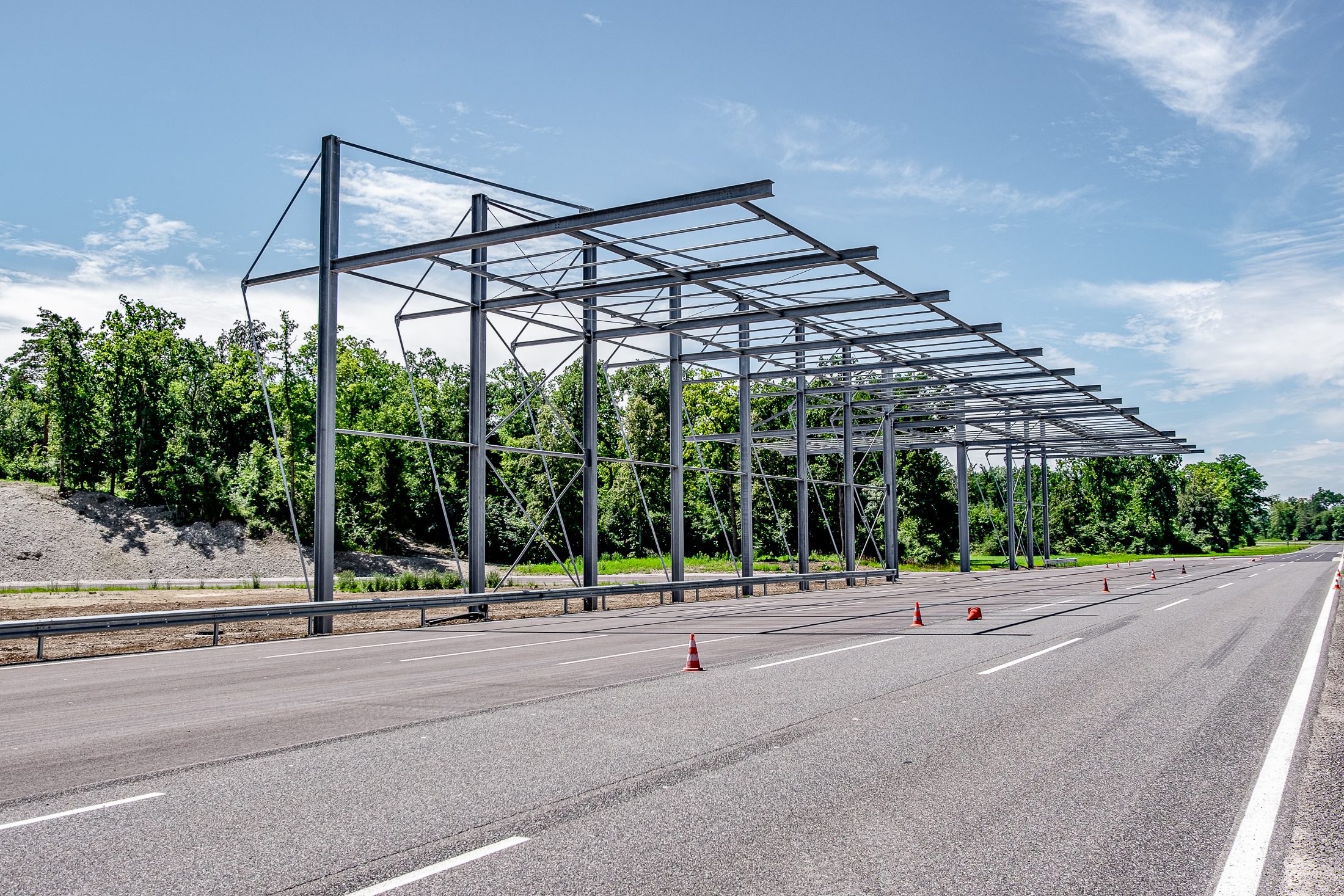
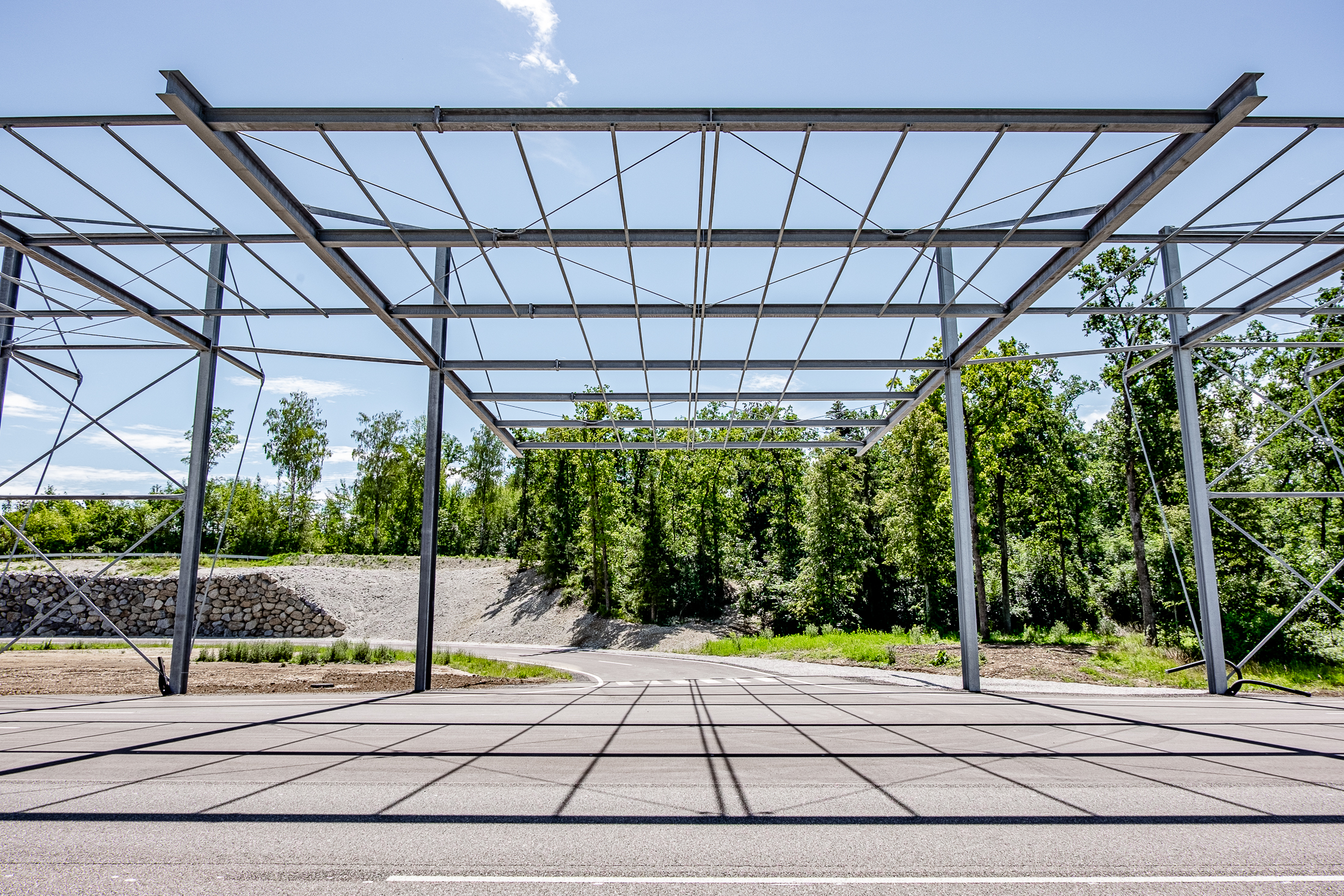
Outdoor rain plant at the Digitrans test center for automated driving in St. Valentin. © DigiTrans GmbH
Are there any similar facilities where autonomous vehicles can be tested in the rain?
The systems and tools used so far often do not provide a realistic replication of natural rain. Until now, these indoor tests could often only be performed at low lengths and heights and at low velocities.
There are systems where, simply put, water falls from above onto the asphalt. However, there is a big difference from which height, in which form, droplet size and homogeneity, intensity and droplet fall velocity the water hits the ground, test objects, vehicles and sensors. We are not aware of any facility that can reproduce defined, natural rain with appropriate intensity, homogeneity, and droplet size outdoors for testing autonomous vehicles and their sensors.
About our interview partner:
Christoph Feichtinger studied industrial engineering at the Graz University of Technology from 2005-2010, focusing on aerodynamics and fuel efficiency of vehicles.
He then worked for the premium car manufacturers Porsche and Audi as a project manager for the simulation and testing of thermal management of various vehicles. From 2014 to 2019, he led the aerodynamic development of KTM’s road racing activities, including the moto3, moto2 and MotoGP motorcycle classes.
Since October 2019, he has been head of research and development at DigiTrans GmbH. In this role, he is responsible for the testing and deployment of highly automated vehicles with a focus on operational environments away from traditional road traffic. In 2021, he completed his doctoral thesis on racing motorcycle dynamics with a focus on aerodynamics.

DI Dr. Christoph Feichtinger
Director R&D / Business Area Manager Know How, Consulting & Dataservices
This could also be interesting
Further Insights
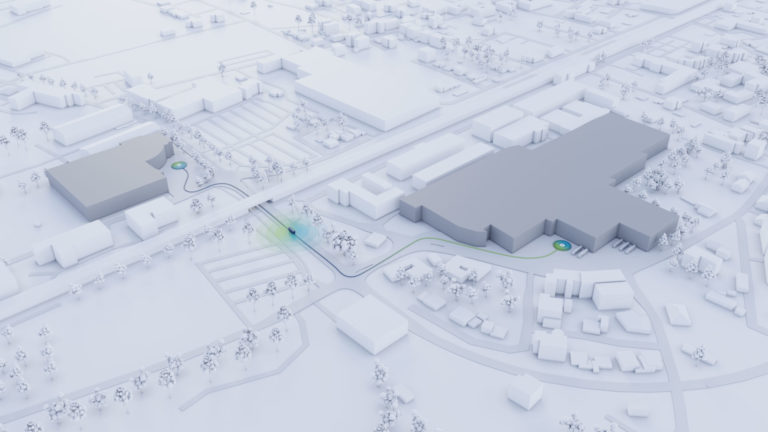
Hub-to-hub transport with autonomous transport systems
In a practical use case, research is being conducted in Upper Austria with the two project partners BRP Rotax and the freight forwarder Schenker on a public transport section with an autonomous transport vehicle to find a hub-to-hub logistics application suitable for everyday use and independent of weather conditions.
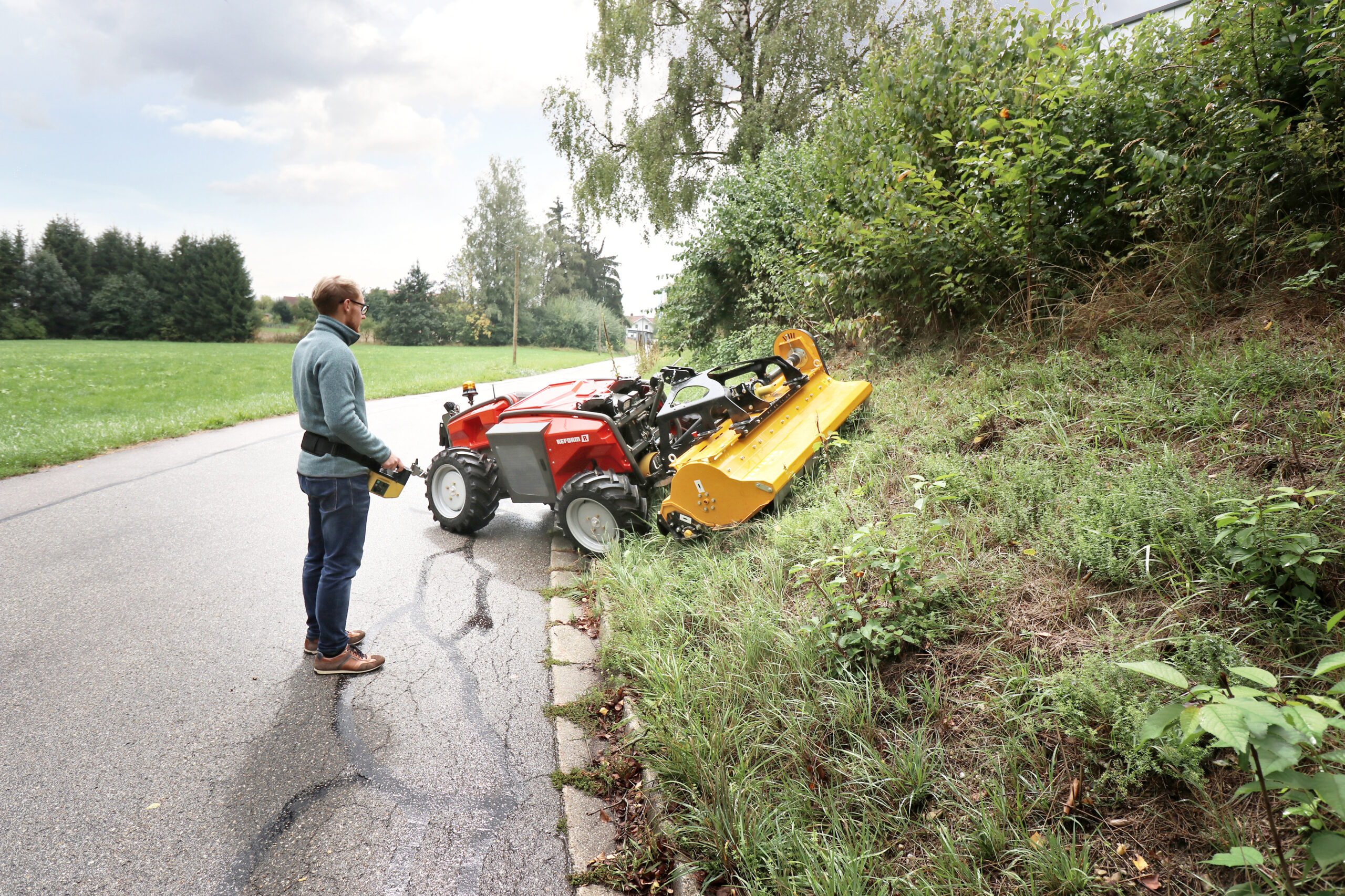
Clear track for testing automated commercial vehicles
Until now, the use of automated commercial vehicles for testing has been limited. One of the major hurdles up to now has been legislation. At the end of last year, DigiTrans GmbH worked together with Reform-Werke on a change in the law that is unique in Europe.
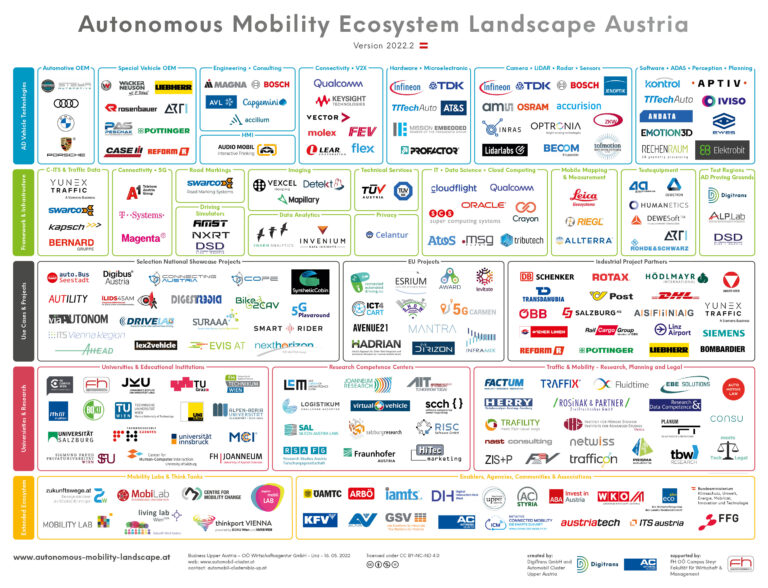
Autonomous Mobility Ecosystem Landscape Austria – Version 2022.2
The first edition of the “Autonomous Mobility Ecosystem Landscape Austria” was published at the end of January 2022. With the new update, the landscape provides an overview of all active companies, research and educational institutions as well as current projects and use cases in the field of autonomous driving in Austria.


